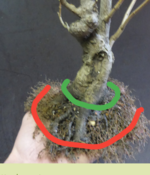Zathura
Seedling
- Messages
- 17
- Reaction score
- 12
I'm super new to the hobby, and after watching tons of videos and reading articles, I only have a couple questions that nobody seems to address or give the information I'm looking for....
Do exposed roots continue to grow and get larger or do they stop growing as they dry out? Do you have to leave them covered until they get to the size you want before exposing them? It's confusing. I don't know whether I should be trying to expose roots early or trying to goad more uniform growth under the soil before uncovering them.
Also, if there's an obvious gap in the roots, is it possible to scar the bark at the soil line, maybe dab it with some rooting hormone, and cover it in sphagnum? I don't really want to go the tourniquet route if I don't have to.
TIA
Do exposed roots continue to grow and get larger or do they stop growing as they dry out? Do you have to leave them covered until they get to the size you want before exposing them? It's confusing. I don't know whether I should be trying to expose roots early or trying to goad more uniform growth under the soil before uncovering them.
Also, if there's an obvious gap in the roots, is it possible to scar the bark at the soil line, maybe dab it with some rooting hormone, and cover it in sphagnum? I don't really want to go the tourniquet route if I don't have to.
TIA




